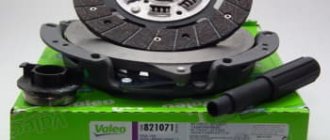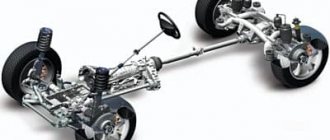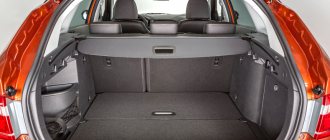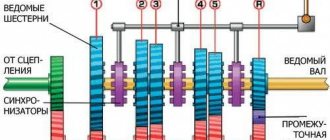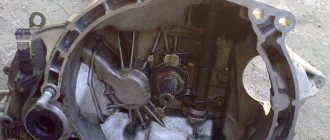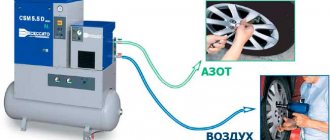Volkswagen cars use a robotic DSG box, but what it is and how to handle the unit is not clear to all owners. Before buying a car, a car enthusiast needs to familiarize himself with the design of the preselective transmission, which displaces classic mechanical units. The reliability of the DSG robot directly depends on the operating modes.
The DSG box is a robotic gearbox.
What is the peculiarity of the DSG box, the principle of operation of the DSG?
DSG is a robotic gearbox with two clutches that allows you to change gears very quickly, due to which the car can accelerate quickly and efficiently. The robot is, structurally, a conventional manual transmission in which the gears are switched automatically.
How does a regular robot or manual box work? To shift up or down, the driver (or the computer) disconnects the clutch disc from the flywheel, engages the desired gear and reconnects the disc. While the gears are switching, torque is not transmitted from the engine to the gearbox, and the car loses dynamics.
In the DSG, these pauses are reduced to a minimum: one clutch is responsible for the odd number of gears (1,3,5,7), and the second for the even number (2,4,6). The car starts, and the odd-numbered disk is pressed against the rotating flywheel. The even row disk is open. While the car is accelerating in first, the computer gives the command to engage the second gear in the even row, and when the moment of switching arrives, the odd row disc is disconnected and the even row disc is immediately engaged. Accordingly, the even row continues to work, and the odd row switches and gets ready to start working.
“Wet” and “dry” versions of the DSG gearbox are used in parallel. The more durable DSG6 is capable of handling high torque and is installed on more powerful cars. DSG7 goes to less powerful versions. DSG under the S-Tronic brand is also installed on Audi cars. Exclusively for this brand, a modernized version of the DSG7 is offered, which retains the concept with dry clutches.
What is DSG
The abbreviation DSG stands for Direkt Schalt Getriebe, or direct gearbox. The design of the unit uses 2 shafts, providing rows of even and odd speeds. For smooth and fast gear switching, 2 independent friction clutches are used. The design supports dynamic acceleration of the car while increasing driving comfort. Increasing the gearbox stages makes it possible to optimally use the capabilities of the internal combustion engine while simultaneously reducing fuel consumption.
What is the difference between DSG6 and DSG7?
There are two types of DSG. The first, in 2003, was the six-speed DSG6 gearbox. The double clutch in it was “wet”, that is, it worked in an oil bath. The main disadvantage of the box is significant power loss due to oil. Therefore, in 2008, Volkswagen introduced a new version - DSG7. This box uses a dry clutch. It was this box that became problematic. When choosing a car with DSG, always pay attention to whether it uses a six- or seven-speed unit. DSG6 can be taken without a doubt, but DSG7 is better left to those who are not well versed in technology.
History of creation
The idea of creating gearboxes with a preliminary selection of stages appeared at the beginning of the last century, the author of the design was Adolf Kegress. In 1940, a 4-speed gearbox developed by engineer Rudolf Frank appeared, which used a double clutch. The design of the unit made it possible to switch stages without interrupting the power flow, which was in demand in the commercial equipment market. The designer received a patent for his invention, and prototypes were made for testing.
At the end of the 70s. A similar design was proposed by Porsche, which developed the 962C racing car project. At the same time, the same gearbox with a dry double clutch was used on Audi rally cars. But further implementation of the units was hampered by the lack of electronics capable of controlling the operation of clutches and gear shifting.
The advent of compact controllers made it possible to begin the development of double-clutch transmissions for mid-price cars. The first version of the classic DSG gearbox with 2 clutches went into mass production at the end of 2002. Borg Warner and Temic took part in the creation of the unit, supplying clutch, hydraulics and control electronics elements. The units provided 6 forward speeds and were equipped with a wet clutch. The product received the factory index DQ250 and allowed transmission of torque up to 350 N.m.
Later, a 7-speed dry-type DQ200 gearbox appeared, designed for engines with a torque of up to 250 N.m. By reducing the oil sump capacity and using compact drives, the size and weight of the transmission have been reduced. In 2009, an improved wet-type DQ500 gearbox, adapted for use on vehicles with front-wheel drive or all-wheel drive, went into production.
The design of the unit is designed for installation of gasoline or diesel engines with a maximum torque of up to 600 N.m.
What malfunctions and problems are typical for DSG?
The most common is shocks when changing gears. The clutch discs close too quickly, causing the car to jerk. Other symptoms also occur: clanging, grinding, jolting and loss of traction in motion. The latter is especially dangerous if the car is in the process of overtaking in the oncoming lane at the moment of traction failure.
As the Peter AT company explained to us, the main problem of the DSG box is a dry clutch. It is subject to accelerated wear, and the root of the problem lies in incorrect algorithms of the mechatronic unit that controls the operation of the box. There are, of course, other malfunctions: occasionally the shaft bushings and clutch release fork wear out, solenoid contacts come off, dirt sticks to the sensors, antifreeze gets into the oil... But these cases are exotic.
The main thing you need to know: if you still bought a post-warranty car with DSG7, and the gearbox shows symptoms of a malfunction, this is not a reason to change its assembly. The gearbox itself, that is, the set of gears, almost never fails. The box can be repaired, which will cost an order of magnitude cheaper than replacement. True, you will have to wait several weeks for spare parts - the demand for them is still low, and spare parts sellers do not have stocks.
Typical problems
Operating principle of DSG.
The weak link in the design of the boxes is the mechatronics, which changes entirely. A failed unit is restored in specialized workshops or in a factory setting. In early versions of wet-type gearboxes, friction lining wear products enter the fluid.
The filter provided in the design becomes clogged with dirt particles; during long-term operation, the unit does not clean the oil. Fine dust is drawn into the gearshift control unit, causing abrasive wear of the cylinders and solenoids.
The service life of a wet clutch is influenced by motor torque. The service life of the clutch is up to 100 thousand km, but if a reprogrammed engine control unit is used, then the mileage before replacement drops by 2-3 times. Dry friction clutches in DSG7 last an average of 80-90 thousand km, but increasing power and torque by updating the motor controller reduces the service life by 50%. The complexity of replacing worn out elements is the same; for repairs it is necessary to remove the gearbox from the car.
DQ500 boxes have a problem with oil escaping through the vent. To eliminate the defect, an extension hose is put on the breather, which is attached to a small-volume container (for example, to a reservoir from a clutch cylinder from a VAZ car). The manufacturer does not consider the defect to be critical.
What is the manufacturer's warranty for the DSG box, free DSG repair and replacement?
Perhaps, in this case, it would be logical to quote verbatim the letter from Volkswagen Group Rus to the heads of dealer service departments. “We hereby inform you of the current rules for processing customer complaints regarding possible malfunctions in the operation of the DSG7 gearbox. VOLKSWAGEN Group Rus LLC, meeting the wishes of customers, in order to maintain confidence in the concern’s cars, as part of an additional obligation, provides customer support in identifying a factory defect in the operation of the DSG 7 gearbox until the expiration of 5 (five) years or until reaching 150,000 km. (whichever occurs first) from the moment the vehicle is handed over to the first buyer. Support is provided in the form of eliminating deficiencies free of charge for the client by repairing or replacing individual gearbox components or the complete unit.”
Sometimes dealers try to refuse warranty repairs to customers, citing the fact that they underwent maintenance at unauthorized stations. According to the law, this cannot be a reason for refusal.
If you have a car under 5 years old and with less than 150,000 kilometers on it, and the dealer refuses to repair the DSG7 for free, complain directly to the Volkswagen hotline.
Also, do not give in to dealers’ persuasion to undergo some kind of scheduled DSG maintenance. The fact is that this is a maintenance-free box, and scheduled maintenance is a way of making money from narrow-minded clients.
Advantages and disadvantages
Advantages of DSG transmission:
- ensuring accelerated acceleration due to short gear switching times;
- reduction in fuel consumption regardless of driving mode;
- smooth gear shifting;
- possibility of manual control;
- maintaining additional operating modes.
The disadvantages of cars with DSG include increased cost compared to analogues equipped with a manual transmission. The mechatronics installed on the boxes fail due to temperature changes; to restore the box's functionality, a new unit will need to be installed. On dry-type units, jerks are observed when switching the first 2 speeds, which cannot be eliminated.
The DSG transmission is not designed for aggressive driving, as shock loads destroy the dual-mass flywheel and friction clutches.
Is it true that Volkswagen has fixed all the problems with the DSG gearbox?
It is a fact that engineers are working on upgrading the DSG. The software and details of the clutch assembly are being improved. However, it is impossible to reliably say that the problem of accelerated wear has been solved. The problem is that the Volkswagen concern prefers to maintain a closed policy and publishes official information about how the box is being finalized. And although since 2014 the 5-year warranty on the DSG no longer applies, there is no reason to say that the reliability problem has been solved.
"Manufacturer's manual"
- Always warm up the engine for 5 to 7 minutes before driving. In such a short time, part of the heat will be taken away by the box to warm up the oil. This means that the drive shafts will be fully washed with oil, the friction force will not increase;
- Fill the gearbox cavity with only as much transmission oil as prescribed in the instructions. This plan is “+ - 100 ml.” it will not work;
- Strictly follow the recommendations and intervals for technical inspection;
- Do not practice sports starts at traffic lights;
- Refill transmission oil strictly in accordance with the markings, viscosity, and classification according to the API system;
- There is a kick when D/R is activated, but not always. This is normal, no need to panic;
- When transitioning from R, D to N and vice versa, there are micropauses;
- When switching to manual mode, when reaching maximum speed, shift to a higher gear. Do not force the engine at critical speeds;
- Pre-installed protection against accidental downshifting when driving at high speeds. The so-called “fool proof”;
- Do not brake the engine, even within the rev range;
- When accelerating smoothly and manually shifting to a lower gear, there will be a slight delay or pause;
- You won't be able to get going from second gear, it just won't turn on;
- Is it possible to skid in winter: you won’t be able to skid on a robot. A clutch package of a different design, unlike an automatic transmission;
- You can tow in the “neutral” position, but no further than 50 km and at a speed no higher than 50 km/h.
Why do cars with DSG7 continue to be produced?
The official position of the company is this: the box provides excellent acceleration dynamics and efficiency. The Germans simply turn a deaf ear to questions about reliability. Further, we can only assume that the reason lies in ordinary business calculations. The development of a gearbox costs billions of euros and cannot simply be abandoned. Obviously, Volkswagen decided that it was easier to spend money on warranty repairs and spread rumors about the increased reliability of the DSG7 than to urgently transfer all of its cars to DSG6, an automatic transmission.
How to drive a DSG correctly
According to statistics, only a third of buyers prefer mechanics, given the same technical characteristics of the car. They prefer two pedals instead of three.
However, of the entire mass, only 15% know and know how to properly use a robotic gearbox.
The mechanics are quite simple to understand, maintain, and repair. In addition, this is a reliable transmission option, regardless of the actual mileage. Does not require systematic maintenance, unlike a robot or hydraulics.
Do not stand in traffic jams with the clutch depressed - one of the few warnings from the manufacturer to motorists. Often, unfortunately, riders forget to take their foot off the pedal, as a result of which the clutch flies in no time.
Why shouldn't you buy a car with DSG7?
Firstly, because despite all the positive qualities of the gearbox, there is no point in playing the lottery and hoping that you will get a car that will not twitch when changing gears and whose gearbox will not “stop” after 50 thousand miles.
Secondly, because cars with DSG7 do not sell well on the secondary market. People who buy used cars tend to be, on average, more technically aware than those who buy new cars from a showroom. Most of them are well aware of the problems with the seven-speed robot, and they rightly will not want to mess with them. Of course, you can always trade-in the car, but with a very big discount, since the salon managers are also in the know.
In any case, the owner of a car with DSG7 will face problems and financial losses. Whether they are worth the pleasure of driving a Volkswagen, Skoda or Audi, everyone decides for themselves.
In what cars can you find
DSG transmissions can be found in Volkswagen, Skoda, Seat or Audi cars. An early version of the DQ250 gearbox was used on Volkswagen cars produced after 2003. The DQ200 version was used on cars such as the Golf or Polo. You can determine the presence of a DSG box by the emblem located on the shift knob.
But since 2015, the Volkswagen concern has abandoned such markings on the levers; the type of transmission is determined by the external appearance of the box (on the side of the crankcase there is a mechatronics unit with a protruding filter cover).
Signs of DSG malfunction, oil change, DIY repairs
- Rapid wear of friction linings and clutches. Reverse gear periodically disappears, and when even-numbered speeds are activated, jerks appear. Frequent transitions to emergency mode, control unit error;
- Wear of solenoids: the appearance of jerks when switching to an increased range of speeds;
- Unstable and incorrect operation of mechatronics and electronic control unit. At the moment of a cold start, the gearbox briefly goes into emergency operation mode, after a few seconds we restore full operation again;
- The key flashes instead of the gear indicator on the dashboard. Operation of the machine is prohibited until the source of the breakdown is identified;
- Wear of bearings, input shaft splines, differential. While driving the car, noise is heard in the area where the gearbox is installed;
- Premature wear of the flywheel, which is accompanied by clanging and noise.
Change transmission oil only at certified centers and official representative offices. When purchasing, do not forget to check the quality of spare parts and compare the catalog numbers of repair kits.
Considering the complexity and design features of the robot, it is impossible to repair it yourself and restore full functionality. Contact service station mechanics for help.
How to extend the life of a robotic gearbox
- It is necessary to forcefully engage first gear when driving in a traffic jam, which prevents the gearbox from constantly rushing between first and second speed. With this seemingly simple movement, we significantly save clutch life.
- The second is to turn on the “Neutral” mode when parking for a long time in one place, for example in the same traffic jam.
- And finally, general advice. Try to move smoothly, without sudden starts and slipping. Do not forget to change the oil in the box, since it is heat-loaded and decomposition products begin to appear more often than in a mechanical one. Although the manufacturer claims that the box is maintenance-free, it still doesn’t work after 60-70 thousand. km. services recommend changing the oil.
To summarize the article, we can say that the DSG gearbox is a modern, economical unit that has not yet been cured of childhood diseases. Therefore, only a new car under warranty should be recommended for purchase.
Or, when buying a used car with such a transmission, budget for repairs, since it cannot be accurately diagnosed. In addition, do not forget about operating tips for a confident and long ride.
Moreover, the VAG concern also has engines of the new TFSI technology, which, like DSG, can create many problems. But this is a topic for another article, but for now I’m telling you about new interesting materials.
Tags
transmission

